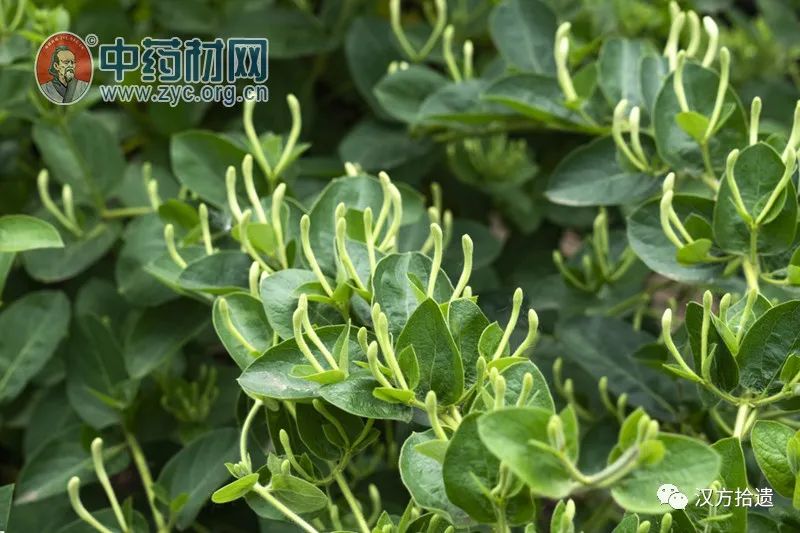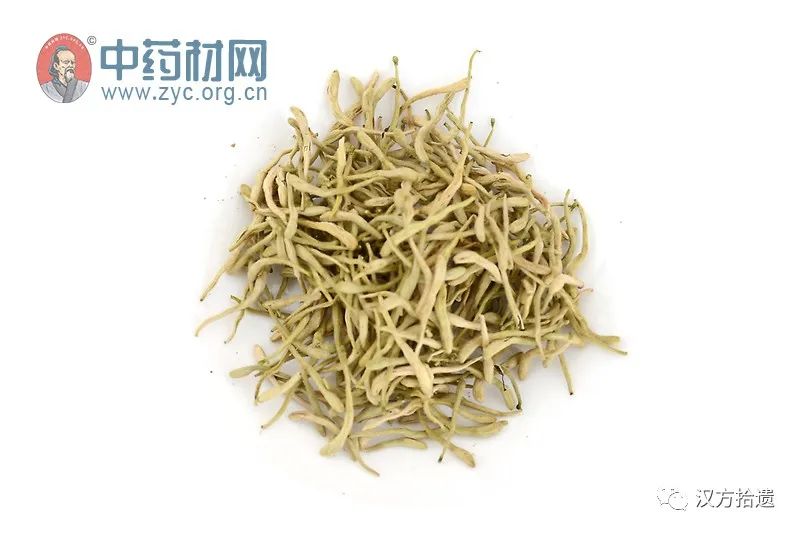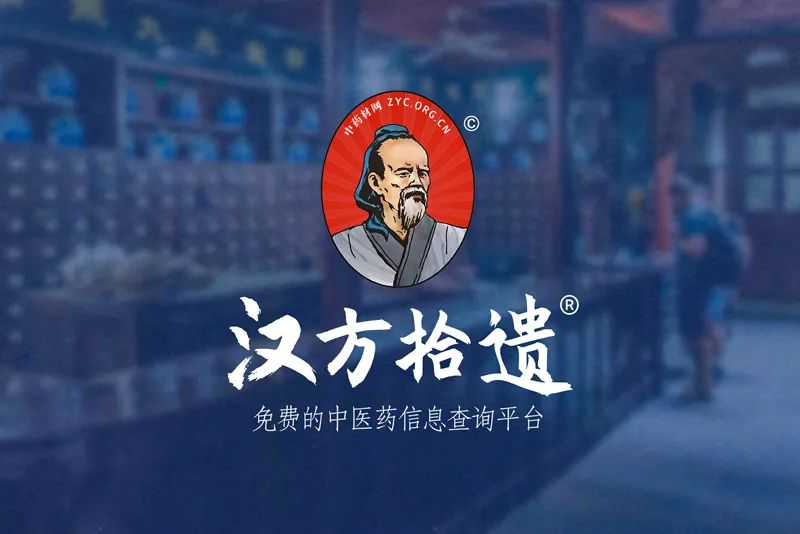Honeysuckle, known in Traditional Chinese Medicine (TCM) as Jin Yin Hua. Other names include: Ren Dong Hua, Shuang Hua, Er Hua, Yin Hua, Lu Ge Hua, Jin Hua, Shuang Bao Hua, Jin Teng Hua. It is the dried flower buds or newly opened flowers of the plants in the Caprifoliaceae family, specifically Lonicera japonica Thunb., L. hypoglauca Miq., L. confusa DC., or L. dasystyla Rehd. It has the properties of clearing heat and detoxifying, as well as dispersing wind-heat. It is primarily used to treat carbuncles, sores, throat obstruction, erysipelas, heat-toxicity dysentery, wind-heat colds, and febrile diseases.
Properties and Channels
It is cold in nature and sweet in flavor. It enters the Lung, Heart, and Stomach meridians.

01
—
Functions and Actions
Functions
Clears heat and detoxifies, disperses wind-heat, cools blood and stops dysentery.
Indications
1. Carbuncles and sores: This herb is sweet and cold, clears heat and detoxifies, disperses carbuncles and reduces swelling, making it essential for treating all internal and external carbuncles.
2. External wind-heat and initial stage of warm diseases: This herb is sweet and cold, aromatic and dispersing, effectively dispersing lung channel heat evil and releasing heat to the surface.
3. Heat-toxicity dysentery: This herb is sweet and cold, has the effect of clearing heat and detoxifying, cooling blood, and stopping dysentery.
4. It can also be used to treat sore throat, children’s heat sores, and prickly heat.
Dosage and Administration
For internal use: decoct 6-15g. To disperse wind-heat and clear internal heat, the fresh product is preferred; charred honeysuckle is suitable for heat-toxicity dysentery; tinctures are often used for summer heat and thirst.
Precautions
Honeysuckle should not be decocted with dandelion as it may produce a cloudy solution, thus it is not suitable for compounding injection solutions.
Chemical Components
This herb contains volatile oils, luteolin, inositol, flavonoids, saponins, tannins, etc. The isolated chlorogenic acid and isochlorogenic acid are the main antibacterial components of this herb.
Pharmacological Effects
This herb has a broad-spectrum antibacterial effect, with strong inhibition against pathogenic bacteria such as Staphylococcus aureus and Shigella. It also inhibits various pathogenic microorganisms including leptospira, influenza virus, and pathogenic fungi; honeysuckle decoction can promote the phagocytic action of white blood cells; it has significant anti-inflammatory and antipyretic effects. This herb has a certain cholesterol-lowering effect. Its water and alcohol extracts have significant cytotoxic effects on sarcoma 180 and ascitic tumors. Additionally, large doses can prevent experimental gastric ulcers. It has a stimulating effect on the central nervous system.
Related Discussions
① “New Reference for Medicinal Slices”: “Clears blood, transforms damp-heat. Treats intestinal wind and dysentery.”
② “Medicinal Materials from Suzhou”: “Cools and detoxifies.”
02
—
Clinical Applications
Clinical Applications
1. For initial stage of carbuncles and sores with redness, swelling, and pain, it can be used alone as a decoction, and the residue can be applied externally to the affected area. It can also be combined with Zao Jiao Ci, Chuan Shan Jia, and Bai Zhi, as in the Xian Fang Huo Ming Yin (“Women’s Good Formula”); for treating carbuncles and toxic swellings that are hard and deep-rooted, it is often used with Zi Hua Di Ding, Dandelion, and Wild Chrysanthemum, as in the Wu Wei Xiao Du Yin (“Medical Collection”); for treating intestinal carbuncles and abdominal pain, it is often combined with Dang Gui, Di Yu, and Huang Qin, as in the Qing Chang Yin (“Differentiation Record”); for treating lung carbuncles with cough and expectoration of pus and blood, it is often used with Yu Xing Cao, Lu Gen, and Tao Ren to clear the lungs and expel pus.
2. For external wind-heat or initial stage of warm diseases with fever, headache, sore throat, and thirst, it is often combined with Lian Qiao, Bo He, and Niu Bang Zi, as in the Yin Qiao San (“Warm Disease Differentiation”); this herb is good at clearing heart and stomach heat toxins, with the ability to transform heat into qi, treating heat entering the nutrient and blood levels, with symptoms of a red tongue, delirium, irritability, and insomnia, combined with Shui Niu Jiao, Sheng Di, and Huang Lian, as in the Qing Ying Tang (“Warm Disease Differentiation”); for summer heat with fever, thirst, headache without sweating, it is used with Xiang Ru, Hou Po, and Lian Qiao, as in the Xin Jia Xiang Ru Yin (“Warm Disease Differentiation”).
3. For heat-toxicity dysentery with purulent blood diarrhea, a concentrated decoction can be effective; it can also be combined with Huang Qin, Huang Lian, and Bai Tou Weng to enhance the effect of stopping dysentery.
Related Combinations
1. Honeysuckle combined with Lian Qiao: Both have heat-clearing and detoxifying effects. Honeysuckle is aromatic and can clear wind-heat, while Lian Qiao is light and good at clearing heart heat, dispersing swelling, and treating sores. Together, they enhance the heat-clearing and detoxifying power, suitable for external wind-heat or initial stage of warm diseases with heat inside and out; for seasonal colds with wind-heat; for sores and carbuncles with redness, swelling, and pain indicating yang syndrome; for wind-heat causing headache, sore throat, red eyes, and itchy rashes.
2. Honeysuckle combined with Huang Qi: Honeysuckle excels at clearing heat and detoxifying, while Huang Qi is good at tonifying qi and promoting wound healing. Together, they work to detoxify, reduce swelling, and promote healing, suitable for those with qi deficiency suffering from carbuncles.
3. Honeysuckle combined with Da Qing Ye: Both have heat-clearing and detoxifying properties. Honeysuckle clears wind-heat, while Da Qing Ye can drain fire and cool blood, effectively clearing heat toxins in the nutrient blood. Their combination significantly enhances the heat-clearing and detoxifying effects, suitable for febrile conditions with sores and toxic swellings, as well as septicemia.
Distinguishing Medicinal Uses
Fresh honeysuckle, charred honeysuckle, and honeysuckle extract: Fresh honeysuckle is the most commonly used, sweet and cold, aromatic and dispersing, effective for clearing heat and detoxifying, treating all carbuncles and sores, external wind-heat, and initial stage of warm diseases. Charred honeysuckle is made from fresh honeysuckle and has a slightly reduced cold nature with a certain astringent effect, mainly entering the stomach and large intestine channels, primarily used for cooling blood and stopping dysentery, often for heat-toxicity dysentery with purulent blood. Honeysuckle extract is made by distilling fresh honeysuckle with water, effective for clearing heat, relieving summer heat, and treating sore throat, as well as children’s heat sores and prickly heat.
Related Medicinal Products
Yin Huang Granules (oral liquid, tablets, injection), Shuang Huang Lian Oral Liquid (granules, tablets, syrup, mixture, capsules), Xiao Er Jie Biao Granules, Qing Re Jie Du Oral Liquid, Yin Hua Cold Powder.
Related Formulas
① For severe pain in sores with purple-black discoloration: 60g of honeysuckle with branches and leaves (chopped), 120g of Huang Qi, and 30g of Gan Cao. Finely chop, add 1 liter of wine, place in a closed container, and simmer for 3-2 hours, strain, and take immediately. (“Essential Methods of Healing” Honeysuckle Powder)
② For treating back sores, ulcers, and pain, to expel pus: 120g of honeysuckle and 30g of Gan Cao (fried). Grind into a coarse powder, take 12g with 1 cup of water and wine, decoct until 1 cup remains, strain, and take warm. (“Health Treasure”)
③ For initial stage of carbuncles: 240g of honeysuckle, 10 bowls of water, decoct until 2 bowls remain, add 60g of Dang Gui, and decoct until 1 bowl remains, take in one go. (“Secrets of the Cave”)
④ For breast abscesses with severe pain: 7.5g each of honeysuckle, Dang Gui, Huang Qi (honey-fried), and Gan Cao. Prepare as one dose, decoct in water, add half a cup of wine, and take warm after meals. (“Essentials of Yin Nourishment” Honeysuckle Powder)
⑤ For long-standing breast lumps that gradually enlarge, with red discoloration and deep ulceration: 15g each of honeysuckle and Huang Qi (raw), 24g of Dang Gui, 5.4g of Gan Cao, and 50 pieces of bitter orange leaves, decoct in equal parts of water and wine. (“Bamboo Forest Gynecology” Honeysuckle Decoction)
Medicinal Cuisine
Honeysuckle Wine:
1. Efficacy: Clears heat and detoxifies. Indicated for sores, lung abscesses, and intestinal abscesses.
2. Ingredients: 50g of honeysuckle, 10g of Gan Cao, 0.15 liters of white wine.
3. Method: Decoct the two herbs in 1 liter of water to obtain 250ml, then add 150ml of white wine, heat slightly, and divide into 3 portions.
4. Administration: Take one portion each in the morning, noon, and evening.

03
—
Processing and Preparation
Harvesting and Processing
Harvest the flower buds or newly opened flowers in late spring to early summer after the morning dew has dried, and dry them promptly or use low-temperature drying.
Preparation Methods
1. Honeysuckle: Take the raw material, remove residual stems, leaves, and impurities, and sift out ash. The raw product is used for clearing heat and detoxifying, and dispersing wind.
2. Fried Honeysuckle: Take clean honeysuckle, place it in a hot pan, and stir-fry over low heat until yellow, then remove and cool. Fried honeysuckle is used for clearing heat and dispersing, and harmonizing the stomach to stop vomiting.
3. Charred Honeysuckle: Take cleaned honeysuckle, place it in a pan, and stir-fry over medium heat until the surface is dark brown, spray with a little water to extinguish flames, dry, and cool. Charred honeysuckle is used for clearing heat and detoxifying, and cooling blood to stop dysentery.
Storage Methods
Store in a dry container in a cool, dry place, preventing moisture and pests. Charred honeysuckle should be stored to prevent heat and re-ignition.
04
—
Identification of Medicinal Materials
Identification
1. The powder of this product is light yellow-brown or yellow-green. It has many glandular hairs, with the head being inverted conical, round, or slightly flattened, consisting of 4-33 cells arranged in 2-4 layers, with a diameter of 30-64-108μm, and the stalk consisting of 1-5 cells, up to 700μm long. There are two types of non-glandular hairs: one is thick-walled, single-celled, up to 900μm long, with fine warty or bubble-like protrusions, some with spiral patterns; the other is thin-walled, single-celled, very long, curved or wrinkled, with fine warty protrusions. Calcium oxalate clusters have a diameter of 6-45μm. Pollen grains are round or triangular, with a surface covered in fine short spines and granular patterns, with 3 pores.
2. Take 0.2g of this product powder, add 5ml of methanol, let it sit for 12 hours, filter, and take the filtrate as the test solution. Also, take chlorogenic acid as a reference, dissolve it in methanol to make a solution containing 1mg per 1ml, as the reference solution. Perform thin-layer chromatography (General Rule 0502), applying 10-20μl of the test solution and 10μl of the reference solution on the same silica gel thin-layer plate, using the upper layer solution of n-butanol-acetic acid-water (7:2.5:2.5) as the developing agent, develop, dry, and examine under ultraviolet light (365nm). In the test solution chromatogram, a fluorescent spot of the same color appears at the corresponding position as in the reference solution chromatogram.
Characteristics of Medicinal Materials
1. Honeysuckle: The flower buds are slender and tapered, thicker at the top and thinner at the bottom, slightly curved, 2-3cm long, with a diameter of about 3mm at the top and about 1.5mm at the bottom. The surface is yellow-white or green-white (darkening with storage), densely covered with short soft hairs. Leaf-like bracts may occasionally be seen. The calyx is green, with 5 lobes at the tip, and the lobes are hairy, about 2mm long. The open flowers are tubular, with a two-lipped tip, 5 stamens attached to the tube wall, yellow; 1 pistil, with a hairless ovary. It has a clear fragrance, with a mild, slightly bitter taste.
2. Lonicera hypoglauca: 2.5-4.5cm long, 0.8-2mm in diameter. The surface is yellow-white to yellow-brown, hairless or sparsely hairy. The calyx tube is hairless, with 5 lobes at the tip, and the lobes are triangular and hairy.
3. Lonicera confusa: 1.6-3.5cm long, 0.5-2mm in diameter. The calyx tube and corolla are densely covered with gray-white hairs, and the ovary is hairy.
4. Lonicera dasystyla: 2.5-4cm long, 1-2.5mm in diameter. The surface is light yellow with a slight purple hue, hairless. The calyx lobes are short and triangular. The open flowers have an irregular upper lip, and the lower part of the flower column is densely covered with long soft hairs.
Characteristics of Medicinal Slices
1. Honeysuckle: Rod-shaped and curved, 20-30mm long, thicker at the top and thinner at the bottom, yellow-white, green-white, or light yellow, with short soft hairs. The calyx is green. It has a clear fragrance and a mild, slightly bitter taste.
2. Fried Honeysuckle: Similar in shape to honeysuckle, but yellow in color.
3. Charred Honeysuckle: Similar in shape to honeysuckle, but dark brown, with a slight charred aroma.
05
—
Botanical Information
Plant Species
Plants in the Caprifoliaceae family, including Lonicera japonica, Lonicera hypoglauca, Lonicera confusa, or Lonicera dasystyla.
Morphological Characteristics
Lonicera japonica: A perennial semi-evergreen shrub with climbing and creeping stems. The young branches are slender, hollow, and the vines are brown to reddish-brown. The ovate leaves are opposite, and both branches and leaves are densely covered with soft hairs and glandular hairs. It flowers in summer, with leaf-like bracts, and the lip-shaped flowers have a faint fragrance, with soft and glandular hairs on the outside. The stamens and pistils extend beyond the corolla, and the flowers grow in pairs in the leaf axils, initially white, gradually turning yellow, with spherical berries that turn black when ripe. The young branches are bright reddish-brown, densely covered with yellow-brown, spreading, stiff, rough hairs, glandular hairs, and short soft hairs, often hairless at the bottom. The leaves are papery, ovate to broadly ovate, sometimes ovate-lanceolate, rarely round-ovate or inverted-ovate, with 1 to several blunt notches, 3-5cm long, with a pointed or gradually pointed tip, rarely blunt, round, or slightly concave, with a rounded or nearly heart-shaped base, with rough edges, dark green above, light green below. The upper leaves of the young branches are usually densely covered with short rough hairs, while the lower leaves are often smooth and slightly grayish-green; the petioles are 4-8mm long, densely covered with short soft hairs. The total flower stalks usually grow singly in the upper leaf axils, equal to or slightly shorter than the petioles, while the lower ones can be up to 2-4cm long, densely covered with short soft hairs and mixed with glandular hairs; the bracts are large, leaf-like, ovate to elliptical, up to 2-3cm long, with short soft hairs on both sides or sometimes nearly hairless; the small bracts are rounded or truncate at the tip, about 1mm long, making up 1/2-4/5 of the calyx tube, with short rough hairs and glandular hairs; the calyx tube is about 2mm long, hairless, with lobes that are ovate or triangular, with pointed tips and long hairs, with dense hairs on the outside and edges; the corolla is white, sometimes slightly reddish at the sunny side, turning yellow later, 3-4.5(-6)cm long, lip-shaped, with the tube slightly longer than the lip petals, rarely nearly equal in length, with rough or semi-erect hairs and long glandular hairs on the outside, the upper lip lobes are blunt, and the lower lip is strap-shaped and reflexed; the stamens and pistils extend beyond the corolla. The flower buds are rod-shaped, thicker at the top and thinner at the bottom. The outer surface is yellow-white or light green, densely covered with short soft hairs. The calyx is small, yellow-green, with lobes that are split at the tips. The open flowers are tubular, with a two-lipped tip, 5 stamens attached to the tube wall, yellow, and 1 pistil with a hairless ovary. It has a clear fragrance, with a mild, slightly bitter taste. The best quality is from unopened flower buds that are yellow-white or green-white, without branches or leaf impurities. The fruit is round, 6-7mm in diameter, glossy black when ripe; the seeds are oval or elliptical, brown, about 3mm long, with a raised ridge in the middle and shallow transverse grooves on both sides. The flowering period is from April to June (often flowering in autumn as well), and the fruit ripens in October to November.
Distribution Area
Lonicera japonica: Distributed in East China, Central South, Southwest, and provinces such as Hebei, Shanxi, Liaoning, Shaanxi, and Gansu.
Production Areas
It is distributed throughout the north and south of China, mainly produced in provinces such as Henan and Shandong.
Growth Environment
Lonicera japonica: Grows in shrubbery or sparse forests on hillsides, in rocky piles, at the foot of mountains, along roads, and near village fences, at altitudes up to 1500m.
Growth Habits
Lonicera japonica: Prefers sunny and mild, humid environments, is vigorous, adaptable, cold-resistant, drought-resistant, and grows poorly in shaded areas.
Reproduction Methods
Propagated by seeds and cuttings.
Cultivation Techniques
1. Seed propagation: Sow in April, soak seeds in 35-40℃ warm water for 24 hours, then take out and mix with 2-3 times wet sand to germinate. When the cracks reach about 30%, sow in rows spaced 21-22cm apart, cover with 1cm of soil, and water every 2 days. Seedlings will emerge in about 10 days, and transplant in autumn or the following spring, using about 15kg of seeds per hectare.
2. Cutting propagation: Generally done during the rainy season. In summer and autumn, select healthy, disease-free 1-2 year old branches, cut into 30-35cm lengths, remove the lower leaves to make cuttings, and use immediately. In selected land, dig holes spaced 1.6m apart and 1.5m apart, 16-18cm deep, inserting 5-6 cuttings per hole, slanting them into the soil, leaving 7-10cm above ground, and compacting the soil (sandy soil with good aeration and drainage is preferred).
Pest and Disease Control
1. Brown Spot Disease: Prune diseased leaves, then spray with Bordeaux mixture at a ratio of 1:1.5:200, every 7-10 days for 2-3 times; or use 65% mancozeb diluted 500 times or 50% thiophanate-methyl diluted 1000-1500 times, spraying every 7 days for 2-3 times.
2. Powdery Mildew: Clean up diseased and residual plants; during the occurrence period, spray with 50% thiophanate-methyl diluted 1000 times or BO-10 biological agent.
3. Aphids: Use 40% dimethoate diluted 1000-1500 times or insecticidal soap diluted 1000-1500 times to spray, repeatedly until eradicated.
4. Cutworms: In spring, dig around the plants within 1m to eliminate pupae. Early in the larval stage, spray with 2.5% fish emulsion diluted 400-600 times; or use dichlorvos or other insecticides, but stop spraying during flowering.
5. Anthracnose: Remove residual plants and diseased leaves, burn them; before transplanting, soak seeds in Bordeaux mixture at a ratio of 1:1:150-200 for 5-10 minutes; during the disease period, spray with 65% mancozeb diluted 500 times or 50% bactericide diluted 800-1000 times.
6. Longicorn Beetles: When adults emerge from the soil, use 80% dichlorvos diluted 1000 times to drench the base. During the oviposition period, spray every 7-10 days with 90% dichlorvos crystals diluted 800-1000 times; if infested branches are found, cut and burn them; if there are holes, insert cotton soaked in 80% dichlorvos and seal with soil to kill the larvae.
|
Special Note: The above content is sourced from the internet, pharmaceutical monographs, magazines, and abstracts, and does not represent the views of Han Fang Shi Yi WeChat subscription platform/Chinese Medicinal Materials Network, nor does it confirm the authenticity of its content. We do not guarantee its scientificity or seriousness in any form. The above content is for reading and reference only and should not be used as a basis for diagnosis. Any other media, networks, or individuals downloading and using content from this website shall bear legal responsibility for copyright and other legal issues. |

|
|
| > About Han Fang Shi Yi |
|
Han Fang Shi Yi (WeChat ID: zycorgcn) is a free TCM health guide. The Chinese Medicinal Materials Network (website: zyc.org.cn) is a linked platform that provides convenient and comprehensive TCM information query services, sharing classic TCM works, health culture, and the development of TCM, dedicated to promoting the essence of Chinese medicine. Free subscriptions are welcome! |
|
|
| > Copyright and Disclaimer |
|
① All content marked asHan Fang Shi Yi (WeChat ID: zycorgcn) original content is copyrighted by this subscription account, and reprints must retain this copyright statement. ② The content or services provided by the Han Fang Shi Yi subscription account are for personal learning, research, or reference, and for other non-commercial or non-profit uses. We will strictly adhere to copyright laws in creating/publishing/reprinting related content. ③ If this subscription account infringes on your legal rights, and the work of a natural person is still under protection, please contact us and provide proof materials, and we will handle it within three working days. |



